OUR 1st TRIP TO AFRICA: KENYA
Travel less, stay longer Photos by Chloé Mukai / ITC
I’m very careful when I travel. I think it’s gross to rush off just for business, then straight back. I always try to do more than one thing on every trip to discover something about the history of the country. Andreas and I, with members of our team, were away for about 10 days working and travelling from Nairobi to Segera, for a safari in the very centre of Kenya.
We’ve been working with the United Nations Ethical Fashion Programme to produce bags and accessories in Kenya. The idea of this programme is to lift communities out of poverty using environmentally sustainable materials and processes. Charity = dependence, Work = control over your own life.
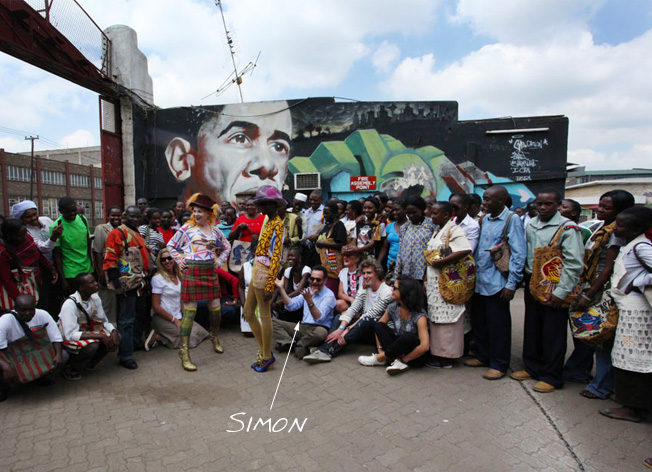 We were given a warm welcome in Nairobi by the people who work on our bags. Simone, who runs the project, had the idea of bringing our designs to the local craftspeople so they can produce attractive fashion items for international markets. Now, after working with them for two seasons, we have 250 local people directly involved in Vivienne Westwood manufacturing. We were really pleased to see what a difference the project has made to the communities they live in.
We were given a warm welcome in Nairobi by the people who work on our bags. Simone, who runs the project, had the idea of bringing our designs to the local craftspeople so they can produce attractive fashion items for international markets. Now, after working with them for two seasons, we have 250 local people directly involved in Vivienne Westwood manufacturing. We were really pleased to see what a difference the project has made to the communities they live in.

Andreas and I spent time at the workshops to work with the craftspeople to add more designs to our range. Eventually, we aim to employ 500 people.
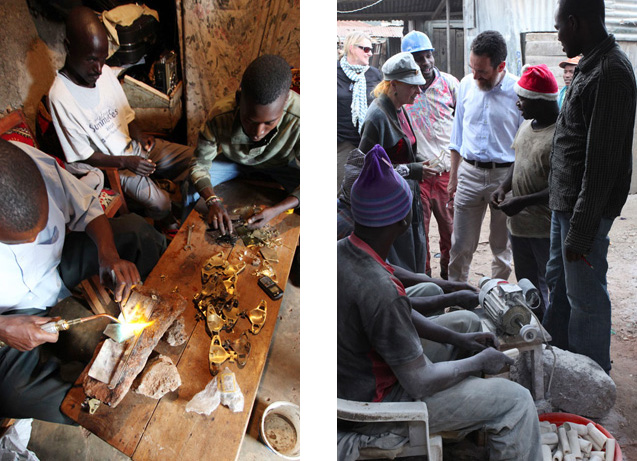 We saw how Stephen and his men make the brass fittings for our bags in his small home in the Nairobi slums. He’s become quite an entrepreneur – locally, the people now call him ‘Stephen Brass’.
We saw how Stephen and his men make the brass fittings for our bags in his small home in the Nairobi slums. He’s become quite an entrepreneur – locally, the people now call him ‘Stephen Brass’.
It was amazing to see how people take bones directly from an abattoir and make them into buttons and jewellery. Simone’s team deals with every challenge and tries to turn it into something positive. A lot of dust is produced when the bones are cut – it was allowed to blow away and was inhaled by the workers who didn’t wear masks to protect themselves. Simone decided it could have value and now plans to use it in rose fertilizer and then, possibly more ambitious, for bone china. These plans have made the dust precious to the men who now conserve the dust and wear masks to protect themselves.
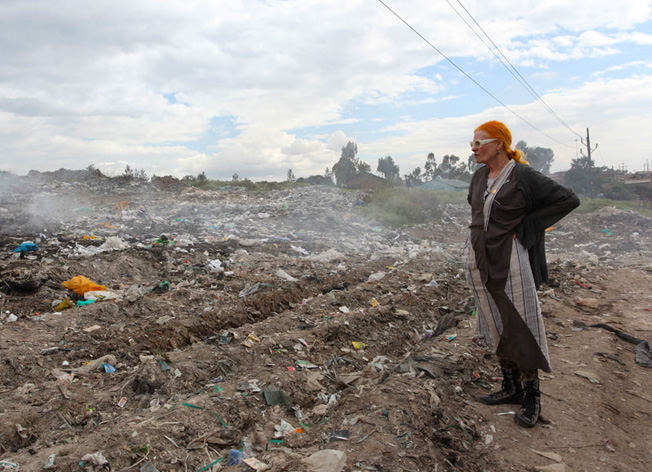 Everything at the rubbish dump is recycled – and some of it is used for our production. It’s an important source of income for slum dwellers. Waste food and rubbish from airlines is collared by slum hierarchies. We visited a supported slum – by NGO’s, charities, people working in town.
Everything at the rubbish dump is recycled – and some of it is used for our production. It’s an important source of income for slum dwellers. Waste food and rubbish from airlines is collared by slum hierarchies. We visited a supported slum – by NGO’s, charities, people working in town.
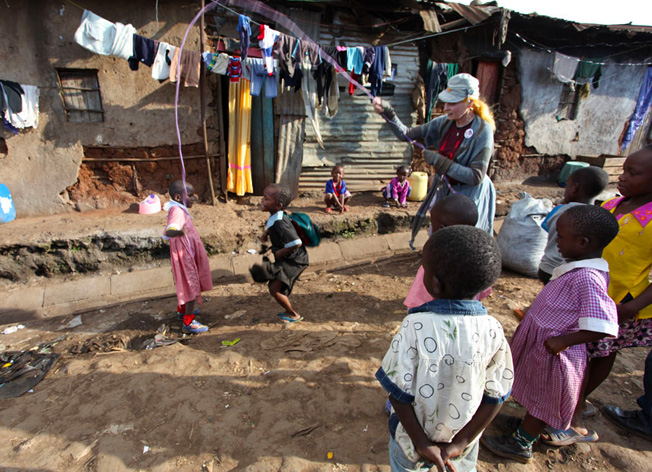 I was surprised to find that the rents for very small concrete houses are not cheap. There’s a whole social structure and economy in the slums – the houses double as shops and workshops. People are healthy, though I’m told the life expectancy is below average. They were happy and friendly to us, especially the children who always greet you with a ‘How are you?’ Second-hand clothes are very important business here – given free by charities but then often sold on. Exceptions are school uniforms; almost all the children wear them, here in pink and blue.
I was surprised to find that the rents for very small concrete houses are not cheap. There’s a whole social structure and economy in the slums – the houses double as shops and workshops. People are healthy, though I’m told the life expectancy is below average. They were happy and friendly to us, especially the children who always greet you with a ‘How are you?’ Second-hand clothes are very important business here – given free by charities but then often sold on. Exceptions are school uniforms; almost all the children wear them, here in pink and blue.
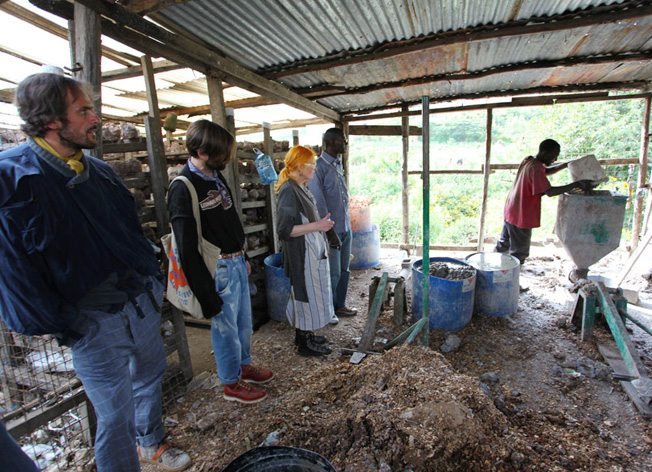 I believe the UN programme is making a really positive impact on the people’s lives. Another small business they started is the production of fuel from paper found at the rubbish dump – like a kind of papier-mache briquette.
I believe the UN programme is making a really positive impact on the people’s lives. Another small business they started is the production of fuel from paper found at the rubbish dump – like a kind of papier-mache briquette.
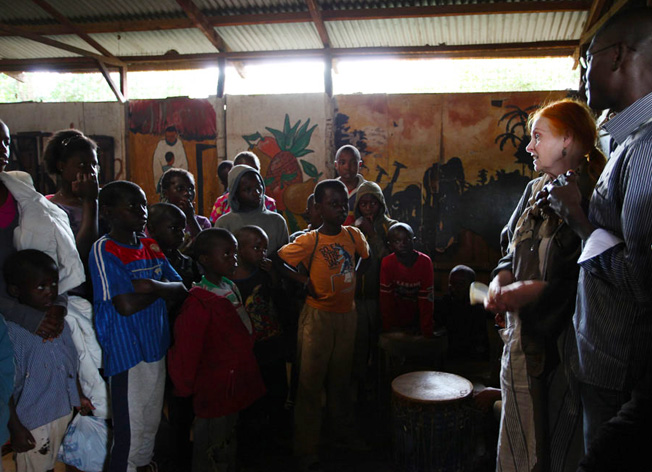 Andreas and I went to this school in Nairobi to meet the students who had previously been working on the rubbish dump – some of them are as young as 4 years old and had been abandoned by their parents. They were rescued by the UN and are now being taught about farming so that they can return to the land and lead healthier lives.
Andreas and I went to this school in Nairobi to meet the students who had previously been working on the rubbish dump – some of them are as young as 4 years old and had been abandoned by their parents. They were rescued by the UN and are now being taught about farming so that they can return to the land and lead healthier lives.
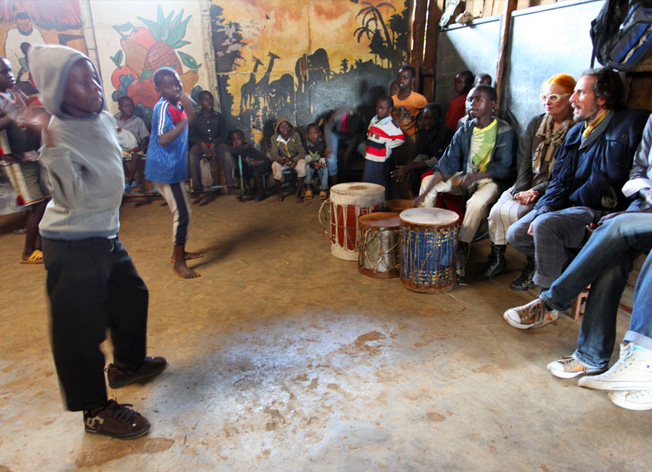 Wherever we went we were given a lively official welcome – singing, dancing and real warmth greeted us at every stop.
Wherever we went we were given a lively official welcome – singing, dancing and real warmth greeted us at every stop.
Our photographer, Juergen Teller – who we always work with on our campaigns – also travelled with us to Kenya to visit the communities involved in the Ethical Fashion Programme. He shot a reportage of the visit which will be displayed as an installation in the Pitti Uomo Palace, Florence, on 16th June. The video highlights issues such as education, access to water, recycling and the ways in which the Ethical Fashion Progamme is helping to improve the quality of life in these communities.
As Juergen was to be with us in Kenya for the UN video, we decided to shoot our next fashion campaign while we were there.
It’s a lot of work doing a fashion shoot – it takes 2 or 3 days to prepare and, as the clothes only arrived the night before, we had been busy for a lot of the night. We also did a casting at the same time.
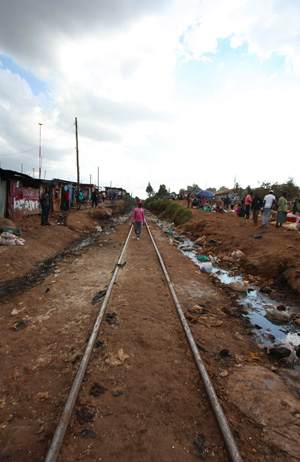 The only railway in Kenya. The infrastructure in the country is really poor. The roads are terrible – one reason why the clothes arrived late for the fashion shoot.
The only railway in Kenya. The infrastructure in the country is really poor. The roads are terrible – one reason why the clothes arrived late for the fashion shoot.
It’s always hard work doing a photo shoot (but I enjoy it) because Andreas and I model in our own publicity – so we are dressing models and ourselves in a van and then coping with doing the shoot outdoors – right amongst people’s lives. People were curious and one lady told me that she admired me for doing such a thing at my age.
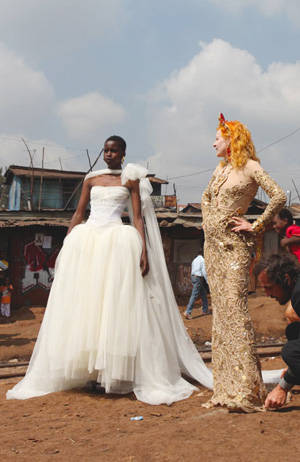
Elsie Njeri was a wonderful model for this gown. When I spoke with her I quickly realized that she’s a very clever girl. Elsie is studying international relations and she knows more about China than I do!
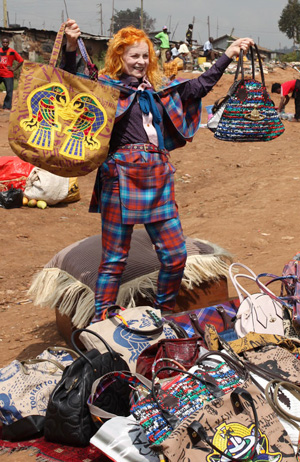 We brought so many accessories with us to Africa that Juergen suggested we pretend we had a shop and were selling things like everybody else. I think you can see that I’m having fun selling our handbags that were made by the women in Nairobi.
We brought so many accessories with us to Africa that Juergen suggested we pretend we had a shop and were selling things like everybody else. I think you can see that I’m having fun selling our handbags that were made by the women in Nairobi.
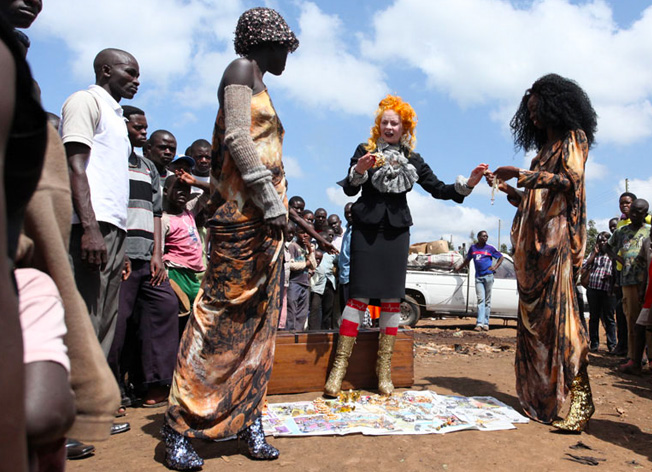 More selling at the market – our jewellery this time. I tried to persuade my friend, the model Ajuma Nasenyana, who I’ve worked with before and Sonnietta Thomas from Nairobi, to buy some.
More selling at the market – our jewellery this time. I tried to persuade my friend, the model Ajuma Nasenyana, who I’ve worked with before and Sonnietta Thomas from Nairobi, to buy some.
After Nairobi, Juergen went home but we went on to Segera Ranch on the Laikipia Plateau – 50,000 acres only 20 miles north of the equator. It was started in 2008 by Jochen Zeitz (owner of Puma) as an ‘ecosphere retreat’ – it is carbon neutral and is one of several of the Zeitz Foundation’s tourist-driven enterprises supporting community development and cultural stewardship, sustainable development, sustainable ecosystem management and conservation. I think it’s an amazing achievement in so short a time.
Segera Ranch is all about conservation and helping the tribal people to live sustainably. Our plan is to provide more work for the people there using their skills to make accessories. You can see this woman using traditional beadwork to produce our design.
There’s a new scheme in Segera that we were very impressed with. The idea is to provide people’s homes (like the ones above) with solar panels. It’s obvious that the bush is really deteriorated and the plan to re-establish it depends on the people not chopping firewood. This saves them a lot of time – and, importantly, the using solar for cooking instead of burning firewood prevents the serious respiratory illnesses which are endemic in the area. The solar panels also provide lighting – this is a real advantage because the children are better able to do their homework in the evenings.
Segera has 18 rangers to protect the park and to educate the native people and visitors. They have formed a drama group and are explaining to us all on our school visit that the animals attract income from tourism and therefore they must conserve the bush, not cut it down.
Segera provides schools for the children. All Kenyans have both English and African names given to them at birth. Their lessons are taught in English and all the signs you see are in English as well. We were surprised that they drive on the left in Kenya – another legacy of the time of British rule.
The children walk to school; it takes some of them 2 hours but they are really determined to study and learn. Here you see a group of girls – the boys are just out of the picture on the other side of the field.
Andreas and I were welcomed by teacher, Millicent, who lives at the school, as do the other teachers because of the remote location and the difficulty of travelling. There are as many as 60 children in a class but they do their best. We were shocked that they don’t have reading books – so I shall send them some when we return to London.
Of course, our visit to Segara was part of a safari but we really enjoyed listening to all the anecdotes and stories. Gabriel oversees Segara and is a mine of information about Kenya and its relation to politics and world events.



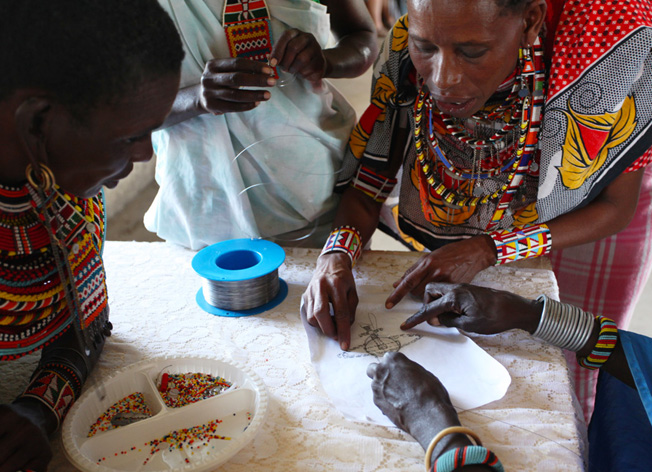


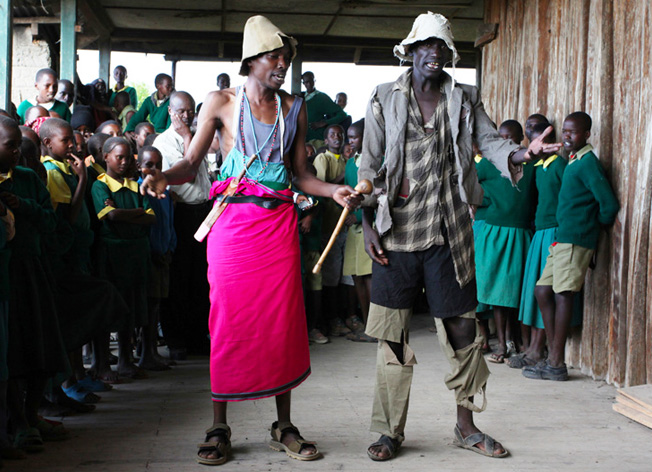
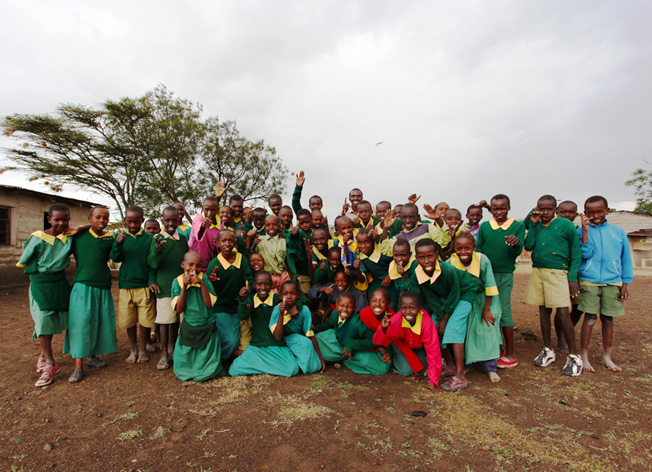
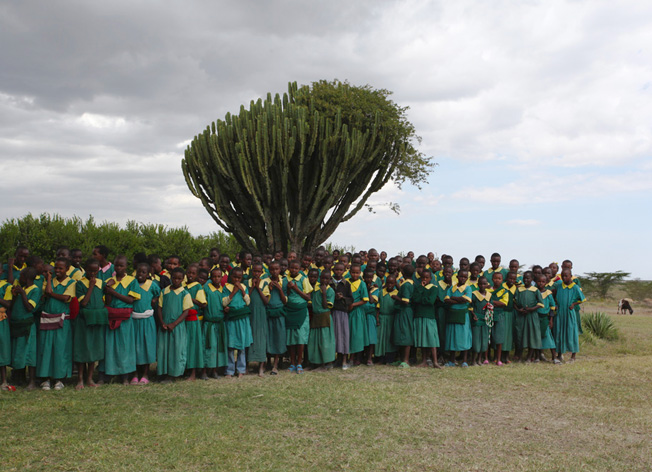

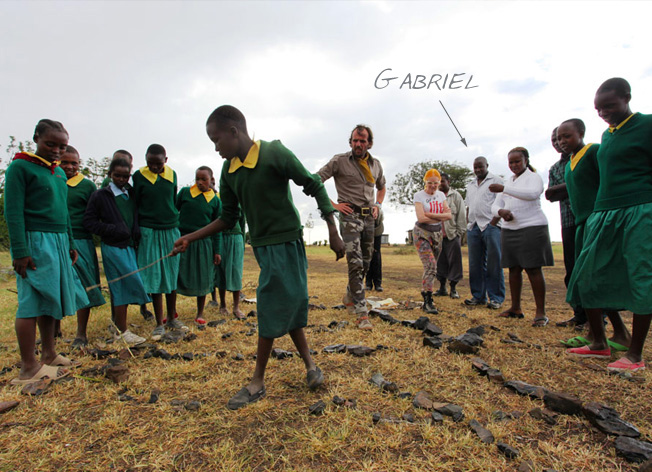


Immensely inspiring. Practical and positive steps that can only lead forward. It’s serious business and serious issues being dealt with here but with genuine skills, hope and a vibrant joy rather than with handouts and cynicism. Wonderful.
Comment by Ruby on 16/06/2011 at 2:19 pm
Thank you so much for sharing this information about your trip to Africa with us, Vivienne! I hope that others in the fashion business will take notice and follow your example in helping to promote ethical fashion and fair trade practices. I find it uplifting and incredibly positive that you are providing jobs for people who otherwise would have none, and I would definitely spend my money to help support their communities.
Thanks again for the detailed post–and pictures–it made my day!
All the Best,
Jeffrey Jordan
Comment by Jeffrey Jordan on 16/06/2011 at 2:46 pm
Love what you are doing Vivienne. I interned at the press office during my first degree and am proud to see the ethical route and the African direction the company has taken over 10 years later. It is inspiring and development is all about creating new market outlets for developing countries and skilled communities who dont often have that opportunity.
Your work in Africa is also causing a BIG buzz in the African fashion bloggers community! My blog focuses on both aspects of African fashion and ethical fashion so glad to be on the same mindset!
Comment by Jacqueline on 17/06/2011 at 11:11 am
You are amazing Vivienne, i am so inspired by your effort to make changes to the world!!
Keep up the good work, and as a big fans of you i will try my best too!
Comment by Shun on 19/06/2011 at 2:52 pm
Dear Vivienne,
I too think that this work is truly inspirational – and I hope that this video in particular will be seen by many people across the UK and further, conveying your message and what you are physically doing about the crucial matters that are happening within the world.
I hope that there is something we can do (and i’m sure that there is) – Which is linked with fashion and Art, and that through these means we can Get A Life, and help to be the change that we see in the world.
Sam
Comment by Sam Varnham on 22/06/2011 at 6:43 pm
It is so inspiring to be able to read about your journey to Africa. Africa has so much to teach us about how our lives are filled with greed, entitlement and waste. I grew up in Africa and my African childhood, though privileged, made me mindful of being wasteful and ungrateful.
Comment by Sonja Morris on 22/06/2011 at 8:22 pm
Working with Vivienne Westwood was one of the best experiences in my life! Honestly i was still in total disbelief after i got home from the shoot,i had to pinch myself a couple of times 🙂 It is such a great deal for me as a new model to work with Vivienne and her team off the bat and I am incredibly grateful for that opportunity,i know that this is just the beggining and it will open more doors in my career!!! Thank you very much Vivienne {^_^}
Comment by Elsie Njeri on 28/06/2011 at 8:58 pm
A great post! I hope you’ll spend more time writing on the line you’re doing in Africa as it continues. The line itself is fantastic looking and really one of the more inspired series I think your company has produced in the past few years and I hope it continues and thrives.
Comment by Emily on 23/07/2011 at 5:40 pm
I lived in Kenya for three years and believe there is a lot of potential there. The Kenyan people are hard workers and they can produce wonderful pieces. Bravo for the initiative and support!!!
Comment by And So I Whisper on 05/08/2011 at 9:59 pm
You are a Queen Goddess! Everything you do is just amazing, dearest Vivienne. So brilliant, thank you for sharing your ingenuity and essence of being human. Much, much love and respect from Manila.
L xx
Comment by Leah Castaneda on 12/09/2011 at 6:58 pm
Very good for contributing to poverty alliviation in our great continent
Comment by BONGOH GEORGE CHENUE on 06/03/2012 at 1:07 pm
you make fashion to have so much more meaning than glamour, thank you for working to improve the livelihoods of people in my country, yours is a worthy corporate social responsibility project.. . . . oh n yes you are an amazing designer. . . .hopefully next time we get to know where to find you. . :)and help you sell in our market 🙂
Comment by Everlyne silong on 25/05/2012 at 2:11 pm